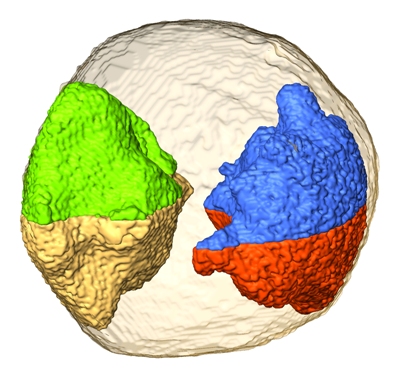A research team led by Jianwei (John) Miao from the University of California, Los Angeles (UCLA) has demonstrated an electron tomography method, which can directly measure a nanomaterial’s atomic structure by creating 3D images of single atoms and their positions in the material.
 Jianwei Miao and colleagues have developed an electron tomography method to image the 3-D structure of a gold nanoparticle at a resolution of 2.4 angstroms. Individual atoms are observed in some regions of the particle and several grains are identified in three dimensions. In the figure, the four three-dimensional grains (green and gold; blue and red) form two pairs of twin boundaries inside the nanoparticle. (Credit: Jianwei Miao/UCLA Physics & Astronomy, CNSI)
Jianwei Miao and colleagues have developed an electron tomography method to image the 3-D structure of a gold nanoparticle at a resolution of 2.4 angstroms. Individual atoms are observed in some regions of the particle and several grains are identified in three dimensions. In the figure, the four three-dimensional grains (green and gold; blue and red) form two pairs of twin boundaries inside the nanoparticle. (Credit: Jianwei Miao/UCLA Physics & Astronomy, CNSI)
In the experiment, a 10-nm-diameter gold nanoparticle was hit with a high-energy electron beam using a scanning transmission electron microscope, generating shadows when the electrons interacted with the atoms of the particle. These shadows provide information about the internal structure of the nanoparticle to a detector placed below the microscope.
The research team found that it was able to reconstruct the internal structure of the nanoparticle as a detailed 3D structure by integrating the data gathered from every single shadow and by acquiring measurement data at 69 different angles.
At present, X-ray crystallography is widely used for viewing 3D molecular structures at atomic-scale resolutions. However, the method can miss some data because it averages the results obtained by measuring millions of virtually identical samples.
The X-ray crystallography technique can measure the structures of perfect crystals. In this experiment, the ULCA team was able to image the structure of the non-crystalline gold nanoparticle in 3D at 2.4 Å resolution. The gold nanoparticle had numerous different crystal grains, wherein atoms were arranged in delicately different patterns. Miao informed that the study of non-crystalline materials is significant because slight differences in structures can drastically modify a material’s electronic properties.
The research team also discovered that the shape of the gold nanoparticle resembled a multi-faceted gem with one side slightly squashed. Other conventional techniques may fail to notice this minute information. This study was inspired by Miao’s previous research, in which he was seeking routes to reduce the radiation dosage administered to patients in CT scans. He discovered a mathematically efficient method that reduces the number of scans to be taken but produces images with the same resolution. He later recognized that this method can be used to study the interiors of nanostructures.
The team’s discovery may enhance the image and resolution quality for tomography study in a broad array of fields, including research on biological samples. The study findings have been reported in the journal, Nature.
Source: http://www.ucla.edu